|
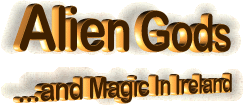
by Ellen Lloyd
May 2006
from
EsoLibris Website
"Not
of the Seed of Adam are we,
Nor is Abraham our Father.
But of the Seed of the Proud Angel
Driven forth from Heaven."
I accidentally came
across this Gaelic chant from the Hebridean island of Barra, while
doing research on the Watchers' activities in various parts of the
world.
The "Proud Angel Driven forth from Heaven" is of course according to
the Christian tradition Lucifer, the fallen angel, who together with
one-third of the angels rebelled against the supreme god Yahweh.
They were all punished and cast out of heaven.
The story of the
genetic warfare between
Yahwew and
the Watchers was covered in 'Giants
- A Result of Genetic Engineering'.
The intriguing question is - what was the Watchers' connection with
the people of Ireland, Britain, and Gaul (mainland Europe)? What
kind of secret, ancient wisdom, were the Druids trying to conceal
and from whom did they gain their magical powers?
According to Julius Caesar, the people of Gaul claimed to be
descendants of Dis (equivalent to Pluto), the God of the Underworld
inhabited by the dead.
Dis is said to have dispatched a group of Gaels from Hades, ordering
them to take possession of Ireland.
-
Was this statement pure
Roman/Christian propaganda on Caesar's behalf?
-
Did the people of
Gaul really pay their tributes to demons, or is the true history of
Gaul more complex?
-
Is it not possible that the Gaelic people did in fact worship our
alien gods, who once upon a time arrived on our planet and seeded
life?
The history of the Celts is indeed often puzzling, and we may
never know the whole truth about these peoples' origins.
However,
taking a closer look at the Druids and their beliefs might help us
cast at least some light on this mystery.
I am a
Serpent, I am a Druid
The Druids belong in the distant past in Celtic history. They were
intelligent and remarkable individuals in a number of ways.
Unfortunately, the information we posses on the Druids, is limited.
These great magicians, as they were often referred to did not keep
any written records of their sacred knowledge. Writing was more or
less prohibited among the Druids. It is therefore difficult to track
their history.
Even if there ever were any Druidic documents, which
seems unlikely they would not have survived after the Roman
invasion. Although many Irish epics do in fact speak of the Druids,
none of the Irish source literature is actually written by the
Druids themselves.
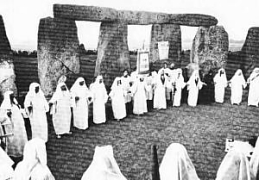
Modern Druids
From what we know about the Druids, they existed in Britain, Ireland
and throughout Gaul.
Their main function in the society was
priesthood, but not only. These Celtic priests acted also often as
doctors, teachers, scientists, judges, and advisers to the kings.
To become a Druid was not an easy task. Druidic training could take
as much as 20 years, and since writing was discouraged, the student
had to memorize sometimes up to 20,000 sacred verses. The most
important mystery schools were located on the Island of Anglesey
(Island of Mona) and on the Island of the Druids, which is now
called Iona. St. Columbo later converted the school on Iona into a
Christian monastery.
After the Roman invasion, Druidism was prohibited in Britain and
Gaul, but the Druids remained powerful on Ireland until the coming
of the Christian era.
The Druids shared a number of beliefs with the ancient Egyptians.
They were Sun worshippers, they taught reincarnation, and they
believed in the immortality of the soul. These mysterious priests
were familiar with the secrets of the universe. They were skilled
astronomers and they possessed the ability to read celestial
patterns.
Caesar's comment on their astronomical knowledge was the following:
"They discuss and
impart to they youth many things respecting the stars and their
motions, respecting the extent of the universe and of our earth,
respecting the nature of things, respecting the power and the
majesty of the immortal gods."
Nature played a vital
role in the life of every Druid.
Secret rituals were carried out in
caves and forests. Certain hills, groves, and stones were considered
to sacred.
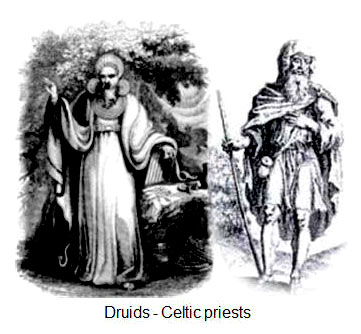
What perhaps most
characterized the ancient Druids were the spells through which it
was believed that they gained their magical powers.
They used to meet during a full moon night, near a sacred mound or
grove, and if possible during a lighting storm. A circle with
elements of the Dragon was traced upon the ground.
During the
ritual, the priest held his wand high up in the air, while chanting
a sequence of magical words loudly pronounced in each of the four
directions. Incantation was a method used to summon the great Dragon
from which they received their unusual powers. The power was a form
of energy that moved through the Druid's body and enabled him to
perform magic.
The serpent was, as in many other cultures recognized as a symbol of
wisdom and strength.
The Celtic Druids used
to pronounce,
"I am a Serpent. I
am Druid."
No country in Europe is
more associated with the serpent than Ireland.
Ancient sources tell the priests were capable of weather
manipulations. During the Roman and Christian invasion of Britain,
the Druids are said to have cast horrific spells, which resulted in
severe climate changes such as heavy flooding and snowfalls.
This
made it more difficult for the invaders to reach the island,
although they finally overcame these obstacles. On the coastline of
the Menai Strait, the soldiers became terrified and paralyzed as they
watched the Druids casting spells upon them.
Tacitus related
as follows:
"On the coastline, a
line of warriors of the opposition was stationed, mainly made up
of armed men, amongst them women, with their hair blowing in the
wind, while they were carrying torches.
Druids were among them,
shouting terrifying spells, their hands raised towards the
heavens, which scared our soldiers so much that their limbs
became paralyzed.
As a result, they remained stationary and were
inquired. At the end of the battle, the Romans were victorious,
and the holy oaks of the Druids were destroyed."
The Druids were also
renowned soothsayers and they were familiar with the secrets of
levitation.
It is therefore not particularly surprising that the
locals, who were regularly, confronted with these "miracles"
considered these Celtic priests to be true magicians, standing in
direct communication with the ancient gods themselves.
They Came in a
Dense and Dark Cloud
In an Irish manuscript, it is written that:
"All who are adepts
in Druidical and magical arts are the descendants of the Tuatha
De Danaan."
Who were the legendary
Tuatha De Danaan?
The true origin of the
Tuatha De Danaan is unknown. The name means literally "the folk of
the god whose mother is Dana."
These fabled Irish gods appeared one
day, on 1st May (Beltane) out of nowhere.
"They had no
vessels… No one really knows whether it was over the heavens, or
out of the heavens, or out of the earth, that they came. Were
they demons of the Devil - were they men?"
Eochaid Ua Flainn
Actually, the Tuatha De
Danaan were neither demons nor men.
They were the alien gods, the
ancient spacemen, and a group of blond, fair-skinned, and handsome
beings, who ruled the Earth in prehistoric times. Their superior
intelligence, artistic skills, and magical powers, which were based
on highly advanced technology, laid the foundation of Druidism.
Before the Tuatha de
Danaan came to Ireland, they spent seven years in Scotland and
some years in Scandinavia.
According to some of the
earliest sources, the Tuatha de Danaan came from the skies.
In the Book of Ballimote, Fintan, who lived before the Flood gives
us the following account:
"After them, the
Tuatha De arrived
Concealed in their dark cloud
I ate my food with them
Though at such a remote period."
The Tuatha De Danaan
landed in a dense cloud on the top of Sliev-an-lerin, the Iron
Mountain in the County Leitrim.
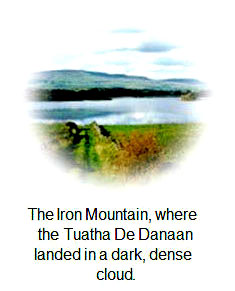
This is very interesting, because it is clear that they appeared in
a manner similar to the Watchers when they descended on Mount Hermon.
In the
Book of Enoch it is written:
"Altogether, they
were two hundred who descended in the days of Jared on the
summit of Mount Hermon."
The Anunnaki, the
Sumerian gods descended also on a mountain. In the Sumerian Epics of Kharsag we read:
"At Kharsag,
where Heaven and Earth met,
the Heavenly Assembly, the great sons of Anu
arrived (descended) - the Many Wise Ones."
Later, the name "Kharsag"
became synonym for "mountain". It is a fact that many ancient
cultures associated their worshipped gods with specific mountains.
We have,
-
the Watchers on Mount
Hermon
-
the Anunnaki at Kharsag
-
the Tuatha De
Danaan on the Iron Mountain
-
Zeus had his
abode on Mount Olympus
-
Indra, known as
the Lord of Heaven
-
the Rider of the
Clouds resided on Mount Meru, north of the Himalayas,
...just to mention a few
examples.
Technology not
of this World
Upon their arrival, the Tuatha De Danaan, the legendary
magicians had to fight two major battles, before they could take
control over Ireland.
In the first battle, they encountered the Firbolgs (the Men of the
Bags), who they defeated at Magh-Tuireadh. Legends relate how the
Tuatha de Danaan cloaked themselves in a mist, which enabled them to
appear and vanish out of sight as they wished. Naturally, this act
completely confused the Firbolgs, who had major problems keeping
track of their enemy.
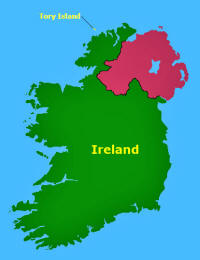
Cloaking technology was
frequently used among the ancient space gods.
In
Voices from
Legendary Times I describe how the alien gods of India for example,
used invisible shields as well as holographic projections. No doubt
that the Tuatha De Danaan were also acquainted with the same
technology.
During the second battle, the Tuatha de Danaan faced the Fomore.
They were evil giants, who launched raids on Ireland from Tory
Island (image right).
One of the leaders of the Fomore was the giant Balor. He
used to send a powerful beam ("flux of energy") across the channel
between Tory Island and Ireland, to blast his enemies. Descriptions
of him suggest that he was rather a machine than a living creature.
He was a frightening
giant, compared to a Cyclops whose eye cast out a beam that turned
his enemies into ashes. Moreover, his only eye could blast a whole
army when he opened the seven eyelids protecting it.
This
undoubtedly special eye of his, had to be kept open with the aid of
metal hooks held up by assistants. During one of the battles, the
god Lugh, using one of his magical weapons, the Assal spear managed
to put Balor's evil eye out of function.
We can only speculate and guess what kind of high-tech weapons Balor
and Lugh were using. Nevertheless, these beings must have been
technologically very advanced.
Why would otherwise the Tory Tower,
the place where the giant Balor lived be vitrified?
After the Fomore were defeated the Tuatha de Danaan reigned
on Ireland for a long time, until they were chased out themselves by
the Milesians at Teltown. During their last battle, these mighty
gods caused a Druidic fog to arise in front of the Milesians.
Apparently, the fog, which covered the island assumed the shape of a
pig. Since then, another name for Ireland has been "Isle of the
Pig".
There are many traces after the Tuatha de Danaan.
For example, the
Isle of Man is named after the Danaan Mananan who set up a mystery
school on the island. He was famous for his powers to transport huge
blocks miles through the air. Our ancient space visitors used this
technology repeatedly, all over the globe, while constructing
incredible monuments, which we admire even today.
It is said that Mananan was also a shape-shifter. Legends describe
how he could change himself into one hundred different persons.
Shining Alien
Gods
Another great god was Lugh ("Lugh of the Long Arm"), also known as
"Chief Doctor of the Sciences". Lugh was the God of Light and
the God of the Underworld. He was young, handsome, extremely
intelligent, and he was widely worshipped in Gaul and Ireland. Lugh
was equivalent to Apollo.
One of the most interesting features about Lugh was his shining
appearance. His face was radiant that no mortals could bear to look
at him!
Now, let us once again return to Enoch's account of the Watchers,
who appear to him as he rests in his bed:
"And there
appear to me two men very tall,
such as I have never seen on earth.
And their faces shone like the Sun, and their
eyes were like burning lamps; and fire came forth from their
lips. "
2En.
1:4-5
Faces "shining like the
Sun" is a characteristic associated with the alien gods, in every
corner of the world.
Tuatha de Danaan were described, as the shining
ones, and some of them were opalescent and seemed to lit up by a
light within themselves.
Magical
Treasures
The Tuatha de Danaan will always be remembered for their
magical powers and supernatural objects, which they brought with
them to Ireland.
These alien gods were in possession of many high-tech devices.
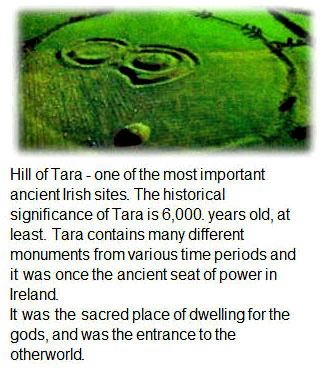
Ancient sources tell us
that they could transform objects and persons with help of the
Magical Rod.
On the Mound of Tara, they placed the Lia Fail, the
Stone of Destiny, which roared by the election of the rightful king. Lugh owned an invisible sword that ensured victory for anyone who
fought with it. The Cauldron of Dagda was a vessel, which could feed
a host of men without ever being emptied.
The alien gods had a boat named Ocean-sweeper. It sailed without a
sail and obeyed the thought of it sailor.
The steed Aonbarr must
have been a flying machine, since it could travel over land and sea.
Alien
Invasion?
Despite their advanced technology, the Tuatha de Danaan seemed to
fear a threat from the skies.
In a manuscript entitled "The Magical
Stone of Tara", it is written that Conn, the Hundred Fighter used to
watch the stars at Tara every night,
"so that no hostile aerial
beings should descend upon Ireland unknown to him."
Was Conn keeping an eye on meteorites, comets, and asteroids or was
he guarding the island from alien sky visitors?
Portals to the Spiritual Underground Kingdom
As mentioned earlier, the Tuatha de Danaan were legendary magicians
and the Druids adopted much of the Irish gods' secret wisdom.
The Tuatha de Danaan were excellent experts on medicine. They could
heal any wound and cure every disease by giving the person a special
drink.
They were skilled in hypnotism and could interpret dreams and omens.
As all other gods across the world, Tuatha de Danaan could soar the
skies by the aid of magical wings. They were very artistic and
highly intelligent.
The saying "Wise as the Tuatha de Danaans" can still be heard
sometimes in the southern parts of Ireland.
So, what happened to these remarkable individuals? Were did they go
after the Mileans defeated them?
According to some legends, the Tuatha de Danaan never left
Ireland. It is believed that they sought refuge in subterranean
palaces. They exist underground in a world, which is accessible
through specific hollow mounds. These hollow hills are known as "sid"
and their inhabitants as "the side". There are certain mounds,
especially near the Boyne and New Grange, which are regarded to be
portals to the spiritual regions of the alien gods.
Another assumption is that some of the Tuatha de Danaans never left
the surface of Earth. Instead, they remained with us as Druids and
continued to teach their magic, sharing their secret wisdom as high
priests.
Whatever happened to all of these magnificent Irish deities is
unknown…
However, one thing is certain, a group of the Tuatha De Danaans
managed to escape from Ireland and travel across the sea. They
traveled trough Wales to Devon and Cornwall, where they continued to
teach their wisdom among the people of Britain…
|





